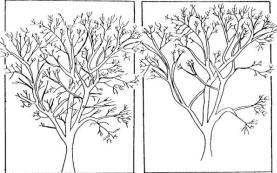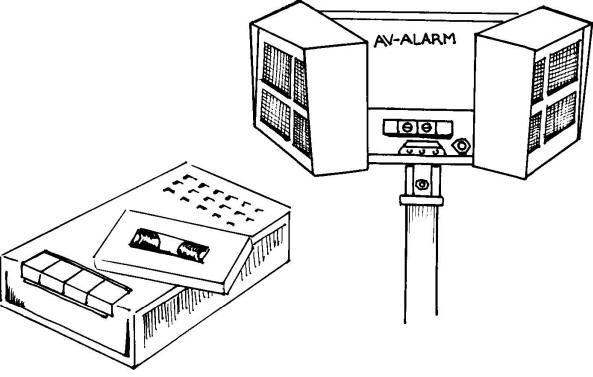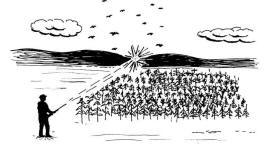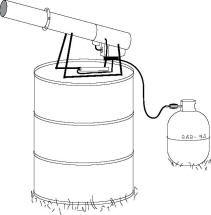|
|
|
|
 |
BIRDS: Bird Dispersal Techniques |
|
|
Introduction
Birds, especially
migratory birds, provide enjoyment and recreation for
many and greatly enhance the quality of our lives. These
colorful components of natural ecosystems are often
studied, viewed, photographed, hunted, and otherwise
enjoyed.
Unfortunately, bird
activities sometimes conflict with human interests.
Birds may depredate agricultural crops, create health
hazards, and compete for limited resources with other
more favorable wildlife species. The management of bird
populations or the manipulation of bird habitats to
minimize such conflicts is an important aspect of
wildlife management. Problems associated with large
concentrations of birds can often be reduced through
techniques of dispersal or relocation of such
concentrations.
Dispersal Techniques
Two general approaches to
dispersing bird concentrations will be discussed in this
chapter: (1) environmental or habitat modifications that
either exclude or repel birds or make an area less
attractive, and (2) the use of frightening devices. The
following chapters in this publication also discuss bird
dispersal techniques in detail: Bird Damage at
Aquaculture Facilities, Birds at Airports, Waterfowl,
and Blackbirds.
Habitat Modifications
Habitat modifications
include a myriad of activities that can make
 Fig.
1. Before and after pruning trees to reduce
attractiveness as a bird roost. Fig.
1. Before and after pruning trees to reduce
attractiveness as a bird roost.
habitats less attractive
to birds. Thinning or pruning of vegetation to remove
protective cover can discourage birds from roosting
(Fig. 1). Most deciduous trees can withstand removal of
up to one-third of their limbs and leaf surface without
causing problems. Adverse effects are minimized during
the dormant season. Thinning often enhances commercial
timber production. Dramatic changes are not always
necessary, however. Sometimes subtle changes are
effective in making an area unattractive to birds and
causing bird concentrations to disperse or relocate to a
place where they will not cause problems. Bird dispersal
resulting from habitat modifications usually produces a
more lasting effect than other methods and is less
expensive in the long run.
Frightening Devices
The use of frightening
devices can be extremely effective in manipulating bird
concentrations. The keys to a successful operation are
timing, persistence, organization, and diversity. Useful
frightening devices include broadcasted alarm and
distress calls, pyrotechnics, exploders, and other
miscellaneous auditory and visual frightening devices
(see Supplies and Materials for information on
commercial products). No single technique can be
depended upon to solve the problem. Numerous techniques
must be integrated into a frightening program.
Electronic Devices.
Recorded alarm and distress calls of birds are very
effective in frightening many species of birds and are
useful in both rural and
 Fig.
2. (a) Recorded bird alarm or distress calls can be
effective in frightening birds. Fig.
2. (a) Recorded bird alarm or distress calls can be
effective in frightening birds.
urban situations. The
calls are amplified and broadcasted (Fig. 2a).
Periodically move the broadcast units to enhance the
effectiveness of such calls. If stationary units must be
used, increase the volume to achieve greater responses.
Electronically produced sounds such as Bird-X , AV-ALARM
, or other sound generators (Fig. 2b), will frighten
birds, but are usually not as effective as amplified
recorded bird calls. This should not discourage their
use, however. The greater the variety and disruptiveness
of sounds, the more effective the method will be as a
repellent.
Pyrotechnics. Pyrotechnic
devices have long been employed in bird frightening
programs. Safe and cautious use of these devices should
be emphasized. The 12-gauge exploding shells (shell
crackers) are very effective (Fig. 3). They are useful
in a variety of situations because of their long range.
Fire shell crackers from the hip (to protect eyes) from
single-barrel, open-bore shotguns and check the barrel
after each round to be sure no obstruction remains. Some
types of 12-gauge exploding shells are corrosive,
requiring that the gun be cleaned after each use to
prevent rusting. Though more expensive, smokeless powder
shells will reduce maintenance.
Pyrotechnics should be
stored, transported, and used in conformance with
(b) Electronically
produced sounds also will frighten birds away from an
area.
laws, regulations, and
ordinances.
Several devices that are
fired from 15mm or 17-mm pistols are used to frighten
birds. For the most part, they cover a shorter range
than the 12gauge devices. They are known by many brand
names but are usually called screamers if they explode,
and if they do not. Both types should be used
together for optimal results. Noises up in the air near
the birds are much more effective than those on the
ground. The use of a shotgun with live ammunition is one
of the most available but least effective means of
frightening birds. Shotgun fire, however, may increase
the effectiveness of other frightening devices. Live
shotgun shells should not be included in a frightening
program unless there is certainty that no birds will be
crippled and later serve as live decoys. Also, live
ammunition creates safety problems in urban areas and is
often illegal. Rifles (.22 caliber) fired from elevated
locations are effective where they can be used safely.
Rope firecrackers are an
inexpensive way to create unattended sound (Fig. 4). The
fuses of large firecrackers (known as fuse-rope salutes
or agricultural explosive devices) are inserted through
5/16- or 3/8-inch (8- or 9.5-mm) cotton rope. As the
rope burns, the fuses are ignited. The time between
explosions can be regulated by the spacing of the
firecrackers in the rope. The ability to vary the
intervals is an asset since birds can become accustomed
to explosions at regular intervals. Burning speed of the
rope can be increased by soaking it overnight in a
saltpeter solution of 3 ounces per quart (85 g/l) of
water and allowing it to dry. Since the burning speed of
the rope is also affected by humidity and wind speed, it
is wise to time the burning of a test section of the
rope beforehand. Because of the fire hazard associated
with this device, it is a good idea to suspend it over a
barrel, or make other fire prevention provisions.
Exploders.
Automatic LP gas exploders are another source of
unattended sound (Fig. 5). It is important to elevate
these devices above the level of the surrounding
vegetation. Mobility is an asset and will increase their
effectiveness, as will changing the interval between
explosions.
Other Frightening
Materials.
Other frightening devices
include chemicals such as Avitrol® and a great variety
of whirling novelties and flashing lights, as well as
innovative techniques such as smoke, water sprays,
devices to shake roosting vegetation, tethered balloons,
hawk silhouettes, and others. While all of these, even
the traditionally used scarecrow (human effigies), can
be useful in specific situations, they are only
supplementary to a basic, well-organized bird
frightening program. Combining different devices such as
human effigies (visual) and exploders (auditory) produce
better results than either device used separately.
 Bird
Dispersal Operations Again, the keys to successful bird
dispersal are timing, persistence, organization, and
diversity. The timing of a frightening program is
critical. Birds are much more apt to leave a roost site
that they have occupied for a brief period of time than
one that they have used for many nights. Prompt action
greatly reduces the time and effort required to
successfully relocate the birds. As restlessness
associated with migration increases, birds will become
more responsive to frightening devices and less effort
is required to move them. When migration is imminent,
the birds natural instincts will augment dispersal
activities. Bird
Dispersal Operations Again, the keys to successful bird
dispersal are timing, persistence, organization, and
diversity. The timing of a frightening program is
critical. Birds are much more apt to leave a roost site
that they have occupied for a brief period of time than
one that they have used for many nights. Prompt action
greatly reduces the time and effort required to
successfully relocate the birds. As restlessness
associated with migration increases, birds will become
more responsive to frightening devices and less effort
is required to move them. When migration is imminent,
the birds natural instincts will augment dispersal
activities.
Fig. 3. Shell crackers are
fired from a 12-gauge shotgun. They produce an aerial
explosion and can be useful in frightening birds out of
fields or away from roosts.
 Fig.
5. Automatic LP gas exploders make loud sounds that
frighten birds. Controlled by a timer, they can be left
unattended. Fig.
5. Automatic LP gas exploders make loud sounds that
frighten birds. Controlled by a timer, they can be left
unattended.

Fig. 4. Rope firecrackers
are relatively inexpensive tools that are useful in
frightening birds.
Whether dealing with rural
or urban concentrations, someone should be in charge of
the entire operation and carefully organize all
dispersal activities. The more diverse the techniques
and mobility of the operation, the more effective it
will be. Once initiated, the program must be continued
each day until success is achieved. The recommended
procedure for dealing with an urban blackbird/starling
roost is given below. Many of these principles apply to
other bird problems as well.
Urban
Roost Relocation Procedure
Willing and
effective cooperation among numerous agencies,
organizations, and individuals is necessary to undertake
a successful bird frightening program in an urban area.
Different levels of government have different legal
responsibilities for this work. The best approach is a
cooperative effort with the most knowledgeable and
interested individual coordinating the program.
Public relations efforts
should precede an urban bird-frightening effort.
Federal, state, and/or local officials should explain to
the public the reasons for attempting to relocate the
birds. Announcements should continue during the
operation and a final report should be made through mass
media. These public relations efforts will facilitate
public understanding and support of the program. They
will also provide an opportunity to solicit citizen
involvement. This help will be needed when the birds
scatter all over town after one or two nights of
frightening. Traffic control in the vicinity of the
roost is essential. Consequently, police involvement and
that of other city officials is necessary.
The public should be
informed that the birds may move to a site that is less
suitable than the one they left and that, if disturbed
in the new roost site, they are likely to return to the
original site. Sometimes it is wise to provide
protection for a new, acceptable roost site once it has
been selected by the birds. One can predict with some
certainty that blackbirds and starlings will move to one
of their primary staging areas if that area contains
sufficient roosting habitat. Fortunately, if the birds
occupy roost sites where they still create problems, a
continuation of the frightening program can more easily
cause them to move to yet another site. With each
successive move, the birds become more and more
responsive to the frightening devices. Habituation is
uncommon in properly conducted programs, especially if
sufficient diversity of techniques and mobility of
equipment is maintained.
Birds are much easier to
frighten while they are flying. Once they have perched,
a measure of security is provided by the protective
vegetation and they become more difficult to frighten.
Dispersal activities should end when birds stop moving
after sunset. A continuation of frightening will only
condition birds to the sounds and reduce responses in
the future. With black-bird/starling roosts, all
equipment and personnel should be prepared to begin
frightening at least 1 1/2 hours before dark. The
frightening program should commence as soon as the first
birds are viewed. Early morning frightening is also
effective. This requires only about 1/2 hour and should
begin when the first bird movement occurs within the
roost, which may be prior to daylight. This movement
precedes normal roost exodus time by about 1/2 hour.
On the first night of a
bird-roost frightening program, routes for mobile units
should be planned and shooters of exploding shells
should be placed so as to build a wall of sound around
the roost site and saturate the roost with sound.
Shooters should be cautioned to ration their ammunition
so that they do not run out before dark. The response of
the birds is predictable. As flight lines attempt to
enter the roost site in late afternoon, they will be
repelled by the frightening effort. A wall of birds
about 1/4 mile (0.4 km) from the roost site will mill
and circle almost until dark. At that time, virtually
all of the birds will come into the roost site, no
matter what frightening methods are employed.
The immediate response of
onlookers is also predictable. Pulling for the underdog
(or in this case the underbirds), they will cheer for
the birds and assume that the program has been
unsuccessful. This is wholesome community recreation.
When the birds are finally gone, however, these same
onlookers will be convinced that frightening devices
are, in fact, effective in moving birds.
By the second and third
nights of the frightening program, flexibility will be
necessary in adapting dispersal techniques to the birds
behavior. As larger numbers of birds are repelled from
the original roost site, they will attempt to establish
numerous temporary roosts. Mobile units armed with
pyrotechnics and broadcast alarm and distress calls
should be prepared to move to these areas, disturb the
birds, and send them out of town. Frightening efforts by
residents should be encouraged through mass media.
Efforts must continue each morning and evening in spite
of weather conditions. Complete success is usually
achieved by the fourth or fifth night.
A bird-frightening program
can be used to deal with an immediate bird problem, but
it can also be an educational tool that prepares
individuals or municipalities to deal with future
problems in an effective manner. Those interested in
resolving the problem should bear part of the financial
burden of the bird-frightening program. This requirement
will immediately eliminate imagined bird problems. When
a city or individual is willing to pay a part of the
bill for a bird-frightening operation, it is obvious
that a genuine problem exists.
Summary
Large concentrations of
birds sometimes conflict with human interests. Birds can
be dispersed by means of habitat manipulation or various
auditory and visual frightening devices. The keys to
effective bird dispersal programs are timing,
persistence, organization, and diversity. The proper use
of frightening devices can effectively deal with
potential health and/or safety hazards, depredation, and
other nuisances caused by birds.
Acknowledgments
Figures 1 through 5 by
Jill Sack Johnson.
Figure 1 adapted from Good
and Johnson (1978).
For Additional Information
Boudreau, G. W. 1968. Alarm sounds and responses of
birds and their application in controlling problem
species. Living Bird 7:27-46.
Boudreau, G. W. 1972.
Factors relating to alarm stimuli in bird control. Proc.
Vertebr. Pest Conf. 5:121-123.
Erdman, S. S. 1981.
Setting up an effective urban blackbird roost control
program. Proc. Bird Control Sem. 8:38-42.
Erdman, S. S. 1982. Public
relations and successful blackbird roost management.
Proc. Great Plains Wildl. Damage Control Workshop
5:252-259.
Garner, K. M. 1978.
Management of blackbird and starling winter roost
problems in Kentucky and Tennessee. Proc. Vertebr. Pest
Conf. 8:54-59.
Good, H. B., and D. M.
Johnson. 1976. Experimental tree trimming to control an
urban winter blackbird roost. Proc. Bird Control Sem.
7:54-64.
Good, H. B., and D. M.
Johnson. 1978. Nonlethal blackbird roost control. Pest
Control 46:14ff.
Mott, D. F. 1980.
Dispersing blackbirds and starlings from objectionable
roost sites. Proc. Vertebr. Pest Conf. 9:38-42.
Mott, D. F. 1985.
Dispersing blackbird-starling roosts with helium-filled
balloons. Proc. East. Wildl. Damage Control Conf.
2:156-162.
Neff, J. A., and R. T.
Mitchell. 1955. The rope firecracker; a device to
protect crops from bird damage. US Dep. Agric. Fish
Wildl. Serv., Wildl. Leaflet No. 365. 8 pp.
Schmidt, R. H., and R. J.
Johnson. 1983. Bird dispersal recordings - an overview.
Pages 43-65 in D. E. Kaukeinen, ed. Vertebr. Pest
Control Manage. Materials, 4th Symp. ASTM STP 817, Am.
Soc. for Testing and Materials, Philadelphia.
US Fish and Wildlife
Service. 1978. Controlling blackbird/starling roosts by
dispersal. Publ. ADC 103. US Dep. Agric., Washington,
DC. 4 pp.
Editors
Scott E. Hygnstrom Robert
M. Timm Gary E. Larson
PREVENTION AND CONTROL OF
WILDLIFE DAMAGE — 1994
Cooperative Extension
Division Institute of Agriculture and Natural Resources
University of Nebraska -Lincoln
United States Department
of Agriculture Animal and Plant Health Inspection
Service Animal Damage Control
Great Plains Agricultural
Council Wildlife Committee
E-24
01/08/2007
Special
thanks to:
Clemson University
|